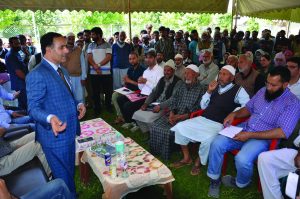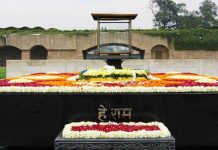 In a first outreach to people in Kashmir Valley following the revocation of Article 370 on August 5, J&K Government has re-launched the Back to Village programme. Under the programme, 5,000 gazzeted government officials are sent to rural areas for two days and one night to interact with the panchayat members. They enquire about the problems of the villagers, ask about the progress of flagship programmes and make an assessment report and recommendation for further action to concerned district development commissioners.
In a first outreach to people in Kashmir Valley following the revocation of Article 370 on August 5, J&K Government has re-launched the Back to Village programme. Under the programme, 5,000 gazzeted government officials are sent to rural areas for two days and one night to interact with the panchayat members. They enquire about the problems of the villagers, ask about the progress of flagship programmes and make an assessment report and recommendation for further action to concerned district development commissioners.
The newly elected Lieutenant governor Girish Chander Murmu has stressed on “bridging the gap between achievable and achieved goals in development and taking governance to doorstep of the rural and inaccessible areas to generate credible and empirical feedback”.
Similarly Principal Secretary Planning Rohit Kansal has said that the principal objective of the Back to Village program is the development and empowerment of Panchayat. He said the program will be mainly based on four themes: one, follow up on the achievements of first Back to Village program early this year. Two ensuring functionality of panchayats in terms of manpower. Three, 100 percent coverage of beneficiary oriented schemes. Four, doubling of income of rural people by giving impetus to rural economy.
The feedback from the latest Back to Village is being incorporated in the formulation of the district development plans.
The Back to Village was first started in June and had been a success. The villagers were delighted to see senior government officials at their door steps and listen to their grievances. Now government wants to repeat it. But this time there is an implicit political dimension to the programme: it is geared to bring people closer to the government by using the administration to solve their problems.
Kashmir has been without any kind of political activity since August 5. All major leaders are under detention. Lieutenant Governor’s rule has also ensured there are no elected political representatives who people can go to. Hence the need to gear up the administration to fill in for the politicians.
At the same time, Back to Village has the advantage of being an apolitical exercise. The officials can meet people in connection with the resolution of their civic problems, not discuss political issues which under the circumstances have achieved a fraught dimension.
“People welcome us. They are happy that it is the senior officials themselves who are visiting them than vice versa” says a senior official who has been a part of the program. “This time also, people will be pleased to see us return to them. Besides, there are many problems of civic nature from the previous exercise which will be taken up now”.
According to District Development Commissioner, Srinagar, Dr Shahid Iqbal Choudhary, around 81 projects worth 5 crore rupees were recently sanctioned as an outcome of recommendations based on the Back to Village programme and as many as 140 recommendations have been submitted to administrative department. As the government has indicated, the focus of the Back to Village is to get the panchayats up and running in the state. The launch of the second phase of the programme will help assess the progress of resolution of priority issues of Panchayats for which 5 crore rupees have been released to each district.
However, observers in Kashmir are not hopeful about the efficacy of the fresh Back to Village unless the administrative measures like these are backed up with a political outreach too. And which won’t be possible unless detained political leaders are released and allowed to carry out their political activities.
letters@tehelka.com












